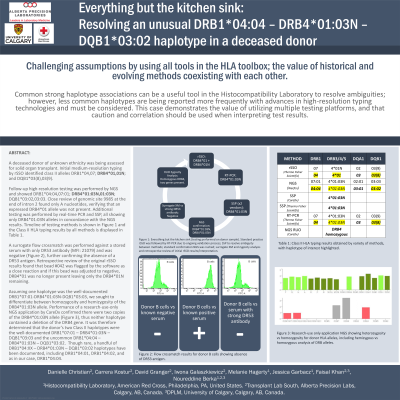Back

Everything but the kitchen sink: Resolving an unusual DRB1*04:04 - DRB4*01:03N – DQB1*03:02 haplotype in a deceased donor
(P420) Everything but the kitchen sink
Location: Platinum Ballroom

- DC
Poster Presenter(s)
Body: A deceased donor of unknown ethnicity was being assessed for solid organ transplant. Initial typing by rSSO assay [Thermo Fisher] identified class II alleles DRB1*04,07; DRB4*01,01N; and DQB1*03:02G,03:03G. Follow-up high-resolution testing was performed by NGS [Werfen] and showed DRB1*04:04,07:01; DRB4*01:03N,01:03N; DQB1*03:02,03:03. Close review of genomic site 9985 at the end of intron 2 found only A nucleotides, verifying that an expressed DRB4*01 allele was not present. Additional testing was performed by real-time PCR [Thermo Fisher] and SSP [CareDx and Thermo Fisher], all showing only DRB4*01:03N alleles in concordance with the NGS results. Complete typing results by all methods is displayed in Table 1.
Surrogate flow crossmatching was performed against a serum with only DR53 antibody (MFI21079) and was negative, further confirming the absence of a DR53 antigen. Review of the original rSSO results found that a bead was flagged by the software as a possible false positive, and when this bead was adjusted to negative, DRB4*01 was no longer present and only the DRB4*01N remained.
Assuming one haplotype was the well-documented DRB1*07:01-DRB4*01:03N-DQB1*03:03, we sought to differentiate between homozygosity and hemizygosity of the DRB4*01:03N allele. Performance of a research-use-only NGS application by CareDx confirmed there were two copies of the DRB4*01:03N antigen (Figure 1), and neither haplotype contained a deletion of the DRB4 gene. It was therefore determined the donor’s two Class II haplotypes were the well-documented DRB1*07:01 – DRB4*01:03N – DQB1*03:03 and the uncommon DRB1*04:04 – DRB4*01:03N – DQB1*03:02.
Conclusion: Common strong haplotype associations can be a useful tool in the Histocompatibility Laboratory to resolve ambiguities, however less common haplotypes are being reported more frequently with advances in high-resolution typing technologies and must be considered. This case demonstrates the value of utilizing multiple testing platforms, and that caution and correlation should be used when interpreting test results.
Surrogate flow crossmatching was performed against a serum with only DR53 antibody (MFI21079) and was negative, further confirming the absence of a DR53 antigen. Review of the original rSSO results found that a bead was flagged by the software as a possible false positive, and when this bead was adjusted to negative, DRB4*01 was no longer present and only the DRB4*01N remained.
Assuming one haplotype was the well-documented DRB1*07:01-DRB4*01:03N-DQB1*03:03, we sought to differentiate between homozygosity and hemizygosity of the DRB4*01:03N allele. Performance of a research-use-only NGS application by CareDx confirmed there were two copies of the DRB4*01:03N antigen (Figure 1), and neither haplotype contained a deletion of the DRB4 gene. It was therefore determined the donor’s two Class II haplotypes were the well-documented DRB1*07:01 – DRB4*01:03N – DQB1*03:03 and the uncommon DRB1*04:04 – DRB4*01:03N – DQB1*03:02.
Conclusion: Common strong haplotype associations can be a useful tool in the Histocompatibility Laboratory to resolve ambiguities, however less common haplotypes are being reported more frequently with advances in high-resolution typing technologies and must be considered. This case demonstrates the value of utilizing multiple testing platforms, and that caution and correlation should be used when interpreting test results.
